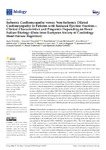Mostrar o rexistro simple do ítem
Ischemic cardiomyopathy versus non-ischemic dilated cardiomyopathy in patients with reduced ejection fraction-clinical characteristics and prognosis depending on heart failure etiology (data from European Society of Cardiology heart failure registries)
| dc.contributor.author | Tyminska, Agata | |
| dc.contributor.author | Ozieranski, Krzysztof | |
| dc.contributor.author | Balsam, Pawel | |
| dc.contributor.author | Maciejewski, Cezary | |
| dc.contributor.author | Wancerz, Anna | |
| dc.contributor.author | Brociek, Emil | |
| dc.contributor.author | Marchel, Michal | |
| dc.contributor.author | Crespo-Leiro, María Generosa | |
| dc.contributor.author | Maggioni, Aldo P. | |
| dc.contributor.author | Drozdz, Jaroslaw | |
| dc.contributor.author | Opolski, Grzegorz | |
| dc.contributor.author | Grabowski, Marcin | |
| dc.contributor.author | Kapłon-Cieslicka, Agnieszka | |
| dc.date.accessioned | 2022-05-23T06:59:52Z | |
| dc.date.available | 2022-05-23T06:59:52Z | |
| dc.date.issued | 2022-02-21 | |
| dc.identifier.citation | Tyminska A, Ozieranski K, Balsam P, Maciejewski C, Wancerz A, Brociek E, et al. Ischemic cardiomyopathy versus non-ischemic dilated cardiomyopathy in patients with reduced ejection fraction-clinical characteristics and prognosis depending on heart failure etiology (data from European Society of Cardiology heart failure registries). Biology (Basel): 2022;11(2):341 | es_ES |
| dc.identifier.issn | 2079-7737 | |
| dc.identifier.uri | http://hdl.handle.net/2183/30715 | |
| dc.description.abstract | [Abstract] Personalized management involving heart failure (HF) etiology is crucial for better prognoses for HF patients. This study aimed to compare patients with ischemic cardiomyopathy (ICM) and patients with non-ischemic dilated cardiomyopathy (NIDCM) in terms of baseline characteristics and prognosis. We assessed 895 patients with HF with reduced left ventricular ejection fraction participating in the Polish part of the European Society of Cardiology (ESC)-HF registries. ICM was present in 583 patients (65%), NIDCM in 312 patients (35%). The ICM patients were older (p < 0.001) and had more comorbidities. The NIDCM patients more frequently had atrial fibrillation (p = 0.04) and lower LVEF (p = 0.01); therefore, they were treated more often with anticoagulants (p = 0.01) and digitalis (p < 0.001). The NIDCM patients were prescribed aldosterone antagonists more often (p = 0.01). There were no other differences as regards the use of HF guideline-recommended medications, implantable cardioverter defibrillators or cardiac resynchronization therapy. The ICM patients were more likely to be treated with statins (p < 0.001) and antiplatelet agents (p < 0.001). All-cause death, as well as all-cause death and readmissions for HF at 12 months, occurred more often in the ICM group compared with the NIDCM group (15.9% vs. 10%, p = 0.016; and 40.9% vs. 28.6%, p = 0.00089, respectively). ICM etiology was an independent predictor of the composite endpoint in the total cohort (p = 0.003). The ICM patients were older and had more comorbidities, whereas the NIDCM patients had lower LVEF. One-year prognosis was worse in the ICM patients than in the NIDCM patients. ICM etiology was independently associated with a worse one-year outcome. | es_ES |
| dc.language.iso | eng | es_ES |
| dc.publisher | MDPI | es_ES |
| dc.relation.uri | https://doi.org/10.3390/biology11020341 | es_ES |
| dc.rights | Atribución 3.0 España | es_ES |
| dc.rights.uri | http://creativecommons.org/licenses/by/3.0/es/ | * |
| dc.subject | Atherosclerosis | es_ES |
| dc.subject | Coronary artery disease | es_ES |
| dc.subject | Heart failure | es_ES |
| dc.subject | Mortality | es_ES |
| dc.subject | Personalized management | es_ES |
| dc.title | Ischemic cardiomyopathy versus non-ischemic dilated cardiomyopathy in patients with reduced ejection fraction-clinical characteristics and prognosis depending on heart failure etiology (data from European Society of Cardiology heart failure registries) | es_ES |
| dc.type | info:eu-repo/semantics/article | es_ES |
| dc.rights.access | info:eu-repo/semantics/openAccess | es_ES |
| UDC.journalTitle | Biology | es_ES |
| UDC.volume | 11 | es_ES |
| UDC.issue | 2 | es_ES |
| UDC.startPage | 341 | es_ES |
Ficheiros no ítem
Este ítem aparece na(s) seguinte(s) colección(s)
-
INIBIC-ICATC - Artigos [156]






